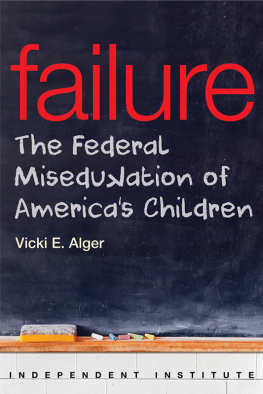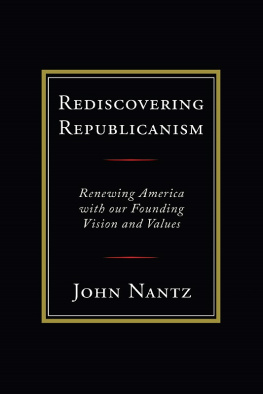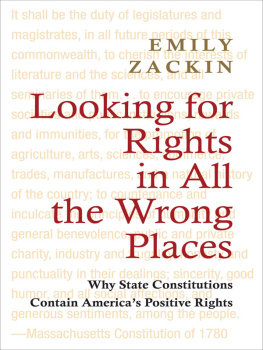failure
failure
The Federal
Misedukation of
Americas Children
Vicki E. Alger

OAKLAND, CALIFORNIA
Failure: The Federal Misedukation of Americas Children
Copyright 2016 by the Independent Institute
All Rights Reserved. No part of this book may be reproduced or transmitted in any form by electronic or mechanical means now known or to be invented, including photocopying, recording, or information storage and retrieval systems, without permission in writing from the publisher, except by a reviewer who may quote brief passages in a review. Nothing herein should be construed as necessarily reflecting the views of the Institute or as an attempt to aid or hinder the passage of any bill before Congress.
Independent Institute
100 Swan Way, Oakland, CA 94621-1428
Telephone: 510-632-1366
Fax: 510-568-6040
Email:
Website: www.independent.org
Cover Design: Denise Tsui
Cover Image: iStockphoto
Library of Congress Cataloging-in-Publication Data
Names: Alger, Vicki E.
Title: Failure : the federal misedukation of Americas children / Vicki E. Alger, Ph.D.
Description: Oakland, CA : Independent Insitute, 2016. | Includes bibliographical references.
Identifiers: LCCN 2014049002| ISBN 9781598132120 (hardback : alk. paper) | ISBN 9781598132137 (pbk. : alk. paper)
Subjects: LCSH: United States. Department of EducationHistory. | Education and stateUnited StatesHistory. | EducationAims and objectivesUnited StatesHistory. | Federal aid to educationUnited StatesHistory.
Classification: LCC LB2807 .A74 2016 | DDC 379.73dc23
LC record available at http://lccn.loc.gov/2014049002
Contents
Acknowledgments
OVER THE PAST several years researching and writing Failure, the support of my husband David was a constant inspiration that made possible its eventual completion.
Well before I began drafting the manuscript, several people provided immense insight into the scope and structure of Failure. I am very grateful to Carrie Lukas for her advice and guidance during the initial planning and outline stages. JuliAnna Jelinek provided indispensible suggestions and help in expanding the original manuscript outline. The many conversations we had helped make the manuscript far better than I thought possible.
I also wish to thank several colleagues and friends whose research assistance and recommendations have helped make Failure more comprehensive than I originally imagined. Christina Villegass insights on the early history of American education, before the advent of government schooling, helped bring to light the overlooked andespecially from todays perspectiveenviable successes of a diversified education marketplace unfettered by centralized government management. I am also grateful to Diana McKibben for her research assistance in identifying alternative models to an increasingly intrusive US Department of Education. Her suggestions helped reaffirm that our Framers were right to leave constitutional authority over education to parents and citizens in each state.
Evelyn Stacey Heils assistance in exploring the education systems of top-performing countries helped underscore the fact that competition for students among schools, not the size or spending of any government education agency, is a leading factor in strong student and school performance. I thank her for our many conversations over the years on this subject.
During the editing stages of Failure, several people offered comments and suggestions for which I am very grateful. The anonymous reviewers helped strengthen the manuscripts style, organization, and historical content.
I am especially grateful to the Independent Institute and its President, David J. Theroux, for sponsoring and overseeing the entire project. In particular, I am indebted to Independents Acquisitions Director Roy M. Carlisle and Research Director William F. Shughart II for their editorial guidance, to Shelby Sullivan for preparing the Department of Education Chronology, and to the late Publications Director Gail Saari and the rest of the talented staff at Independent for their masterly work at each stage of the books development.
United States Department of Education Chronology
| 1642 | The Massachusetts Bay Colony founds the first compulsory education law in the English-speaking world. |
| 1785 | Congress passes the Land Ordinance, mandating that newly created states in the Western Territory set aside land for the maintenance of public schools. |
| 1787 | The Constitutional Convention is held.
September 14 Government-controlled education is left out of the Constitution by a majority vote. |
| 1789 | The Massachusetts Education Act is adopted, requiring towns with a population over 200 to provide mandatory elementary schooling. Boston passes its own Education Act, leading to the first city-wide system of public schools in the country. |
| 1800s | Education reformers shift focus from trying to achieve universal education to uniform education in response to religious tensions and a rise in immigrants. |
| 1837 | The Massachusetts Board of Education is formed, the countrys first state education board. |
| 1857 | The National Education Association is formed as the National Teachers Association. |
| 1859 | February 24 President Buchanan vetoes the original Morrill land-grant bill. |
| 1862 | July 2 President Lincoln signs the Morrill Act into law, funding nearly 60 colleges through public land grants. |
| 1866 | February 7 At its annual meeting the National Association of School Superintendents forms a committee to propose a national education bureau in Congress.
February 14 US Representative James A. Garfield introduces the proposal and a draft bill in the House of Representatives. |
| 1867 | The first national education department is created.
February 27 The bill establishing a national education department is passed.
March 2 President Andrew Johnson signs An Act to Establish a Department of Education into law. |
| 1868 | July 20 Congress downgrades the Department of Education to an Office of Education within the Department of the Interior. |
| 1870 | March 3 Congress again downgrades the Office of Education to a Bureau of Education within the Department of the Interior. |
| 1914 | The Smith-Lever Act of 1914 and the Smith-Hughes Act of 1917 extend the education offices reach into secondary education. |
| 1939 | The Office of Education is transferred to the newly-created Federal Security Agency. |
| 1953 | The Federal Security Agency is reorganized as the Department of Health, Education, and Welfare, which now includes the Office of Education. |
| 1958 | The National Defense Education Act is enacted. While primarily focused on higher education, this law marks the first significant federal effort directed at elementary education as well as secondary education. |
| 1965 | The Elementary and Secondary Education Act (ESEA) is signed into law, increasing federal control over education through tax-based grants. It requires regular program evaluations as a condition of funding, but this requirement is largely ignored. |
| 1970 | The ESEA is reauthorized in spite of ongoing evidence that funds are being misspent. Requirements are added that federal aid is to supplement, not supplant, state and local aid to schools. The ESEA is amended and expanded in 1972 and 1974. |
Next page









